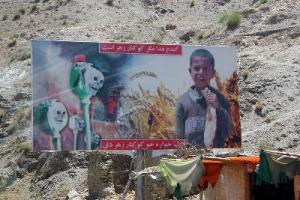Consequences of Prohibition
Drug War Issues
The amount of opium produced in Afghanistan this year has increased dramatically, the UN Office on Drugs and Crime (UNODC) said in a report Tuesday. Production is up 61% over last year, according to the 2011 Afghan Opium Survey jointly released by UNODC and the Afghan Ministry of Counter Narcotics.

Afghan opium eradication poster. Apparently, no one is paying attention. (wikimedia.org)
Production declined dramatically last year owing primarily to a blight that struck opium poppies. But this year, poppy was back with a bang. Not only did opium production increase dramatically, but the amount of land sown with poppy also increased, although not so dramatically. The number of hectares under poppy production increased from 120,000 last year to 131,000 this year, up 7%. That was to be expected after last year's blight caused raw opium prices to soar.
UNODC estimated the farm gate value of the poppy crop at $1.4 billion or about 9% of Afghanistan's gross domestic product. But when heroin processing and trafficking is added to the mix, poppy takes on an even greater role in the national economy, contributing to something between one-third and one-half of all economic activity.
UNODC estimated that the Taliban receives 10% of poppy harvest proceeds, or around $140 million a year. But that figure is even larger when Taliban taxation of or involvement in opium and heroin trafficking is taken into account.
Poppy production is centered in areas that are largely outside the control of the government in Kabul. The Taliban bastions of Helmand and Kandahar provinces accounted for the majority of Afghan opium production, with production also booming in conflictive Nangahar province along the Pakistan border in eastern Afghanistan.
This year's estimated 5,800 metric tons of opium production, while a large increase over last year, is still below Afghanistan's peak production. In 2006 through 2009, production was over 6,000 metric tons each year, reaching nearly 8,0000 metric tons in 2007. Still, Afghanistan's position as the world's leading opium producer remains unchallenged, and it accounts for more than 80% of global opium production.
This work by StoptheDrugWar.org is licensed under Creative Commons Attribution-ShareAlike 4.0 International
Comments
opium production
the article says that the Taliban gets about 10% of poppy harvest proceeds, I'd like to know what the CIA's cut is??????
In reply to opium production by jakester (not verified)
CIA cut?
The CIA pays the cut, they're in charge silly! Everyone knows that...Nudge,nudge,wink,wink. ;)
harper's opium human trafficking profits
Opium production is up in Afghanistan - and sales of mullah segeh and heroin are booming in Harper's Ottawa. Capital of the Western world's slave trade.
harper's opium human trafficking profits
Opium production is up in Afghanistan - and sales of mullah segeh and heroin are booming in Harper's Ottawa. Capital of the Western world's slave trade.
Add new comment